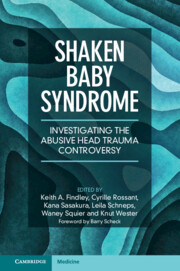122 results
Section 3 - Science
-
- Book:
- Shaken Baby Syndrome
- Published online:
- 07 June 2023
- Print publication:
- 08 June 2023, pp 161-274
-
- Chapter
- Export citation
Chapter 27 - Conclusion
- from Section 6 - Postface
-
- Book:
- Shaken Baby Syndrome
- Published online:
- 07 June 2023
- Print publication:
- 08 June 2023, pp 397-399
-
- Chapter
- Export citation
Abbreviations
-
- Book:
- Shaken Baby Syndrome
- Published online:
- 07 June 2023
- Print publication:
- 08 June 2023, pp xxvii-xxviii
-
- Chapter
- Export citation
Section 2 - Medicine
-
- Book:
- Shaken Baby Syndrome
- Published online:
- 07 June 2023
- Print publication:
- 08 June 2023, pp 33-160
-
- Chapter
- Export citation
Section 4 - Law
-
- Book:
- Shaken Baby Syndrome
- Published online:
- 07 June 2023
- Print publication:
- 08 June 2023, pp 275-320
-
- Chapter
- Export citation
Contents
-
- Book:
- Shaken Baby Syndrome
- Published online:
- 07 June 2023
- Print publication:
- 08 June 2023, pp vii-viii
-
- Chapter
- Export citation
Plate Section (PDF Only)
-
- Book:
- Shaken Baby Syndrome
- Published online:
- 07 June 2023
- Print publication:
- 08 June 2023, pp 433-448
-
- Chapter
- Export citation
Section 1 - Prologue
-
- Book:
- Shaken Baby Syndrome
- Published online:
- 07 June 2023
- Print publication:
- 08 June 2023, pp 1-32
-
- Chapter
- Export citation
Appendix: Frequently Repeated Claims concerning Shaken Baby Syndrome
-
- Book:
- Shaken Baby Syndrome
- Published online:
- 07 June 2023
- Print publication:
- 08 June 2023, pp 400-412
-
- Chapter
- Export citation
Index
-
- Book:
- Shaken Baby Syndrome
- Published online:
- 07 June 2023
- Print publication:
- 08 June 2023, pp 413-432
-
- Chapter
- Export citation
Dedication
-
- Book:
- Shaken Baby Syndrome
- Published online:
- 07 June 2023
- Print publication:
- 08 June 2023, pp v-vi
-
- Chapter
- Export citation
Copyright page
-
- Book:
- Shaken Baby Syndrome
- Published online:
- 07 June 2023
- Print publication:
- 08 June 2023, pp iv-iv
-
- Chapter
- Export citation
Chapter 15 - When Lack of Information Leads to Apparent Paradoxes and Wrong Conclusions
- from Section 3 - Science
-
-
- Book:
- Shaken Baby Syndrome
- Published online:
- 07 June 2023
- Print publication:
- 08 June 2023, pp 236-248
-
- Chapter
- Export citation
Section 6 - Postface
-
- Book:
- Shaken Baby Syndrome
- Published online:
- 07 June 2023
- Print publication:
- 08 June 2023, pp 397-399
-
- Chapter
- Export citation
Section 5 - International
-
- Book:
- Shaken Baby Syndrome
- Published online:
- 07 June 2023
- Print publication:
- 08 June 2023, pp 321-396
-
- Chapter
- Export citation
About This Book
-
- Book:
- Shaken Baby Syndrome
- Published online:
- 07 June 2023
- Print publication:
- 08 June 2023, pp xxiii-xxvi
-
- Chapter
- Export citation

Shaken Baby Syndrome
- Investigating the Abusive Head Trauma Controversy
-
- Published online:
- 07 June 2023
- Print publication:
- 08 June 2023
The algebra of cell-zeta values
- Part of
-
- Journal:
- Compositio Mathematica / Volume 146 / Issue 3 / May 2010
- Published online by Cambridge University Press:
- 10 March 2010, pp. 731-771
- Print publication:
- May 2010
-
- Article
-
- You have access
- Export citation
Contents
-
- Book:
- Hodge Theory and Complex Algebraic Geometry II
- Published online:
- 21 December 2009
- Print publication:
- 03 July 2003, pp v-x
-
- Chapter
- Export citation
10 - Mumford's Theorem and its Generalisations
-
- Book:
- Hodge Theory and Complex Algebraic Geometry II
- Published online:
- 21 December 2009
- Print publication:
- 03 July 2003, pp 278-306
-
- Chapter
- Export citation



